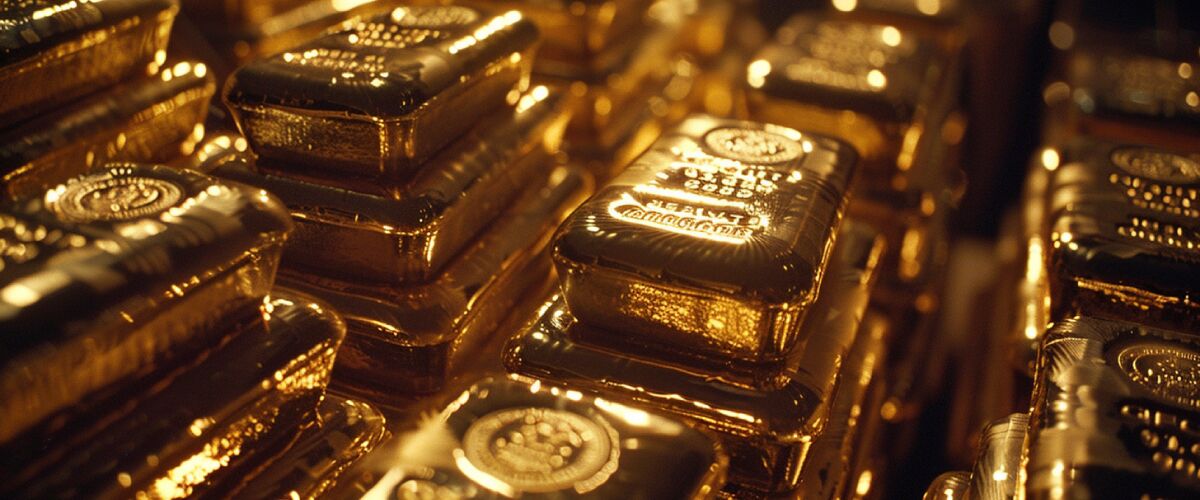Gold has long been a trusted store of value. For proof, we need look no further than a trip to the Egyptian pyramids or many other ancient sacred sites.
But the use of gold to underpin a monetary system is much more recent. The classic gold standard let paper money convert into a fixed amount of gold. This standard didn’t start until the 17th century.
Great Britain was the first country to set a gold standard for itself and its colonies. This included the United States. For over two centuries, from 1717 to 1931, anyone with Bank of England banknotes could trade them for gold at a fixed rate.
Protect Your Wealth with an Offshore Plan B in 2025
Protect your hard-won nest egg. Join the thousands of Americans who get our best wealth protection insights & offshore strategies sent straight to their inboxes.
The early years of this period coincided with the beginning of the industrial revolution and the rise of the British Empire. The gold standard was widely adopted. It led to fixed exchange rates between countries that recognized it.
Businesses that traded internationally benefited from this system. This meant they could accept payment in a local currency whose value was pegged to the pound at a fixed exchange rate.
The gold standard also enforced governmental frugality. A country couldn’t correct a trade deficit by devaluing its currency and thus making its exports more competitive. Instead, the change would need to occur in the real economy. This could be an increase in productivity or a cut in government spending.
The End of the Global Gold Standard
But gold had a comparatively brief reign. And World War 1 (1914-1918) was its death knell. Countries raced to mobilize for war. But, the gold standard’s rules made it nearly impossible to increase war spending. Most nations involved in the fighting, including the United States and Britain, abandoned the gold standard.
Once convertibility was restored, Britain decided to use the same pound to gold exchange rate it had prior to the outbreak of hostilities in 1914. That was a fateful decision. It meant the pound was overvalued based on the British economy’s capacity to produce goods for profitable export.
In contrast, France devalued its currency in relation to gold. So, in relation to each other’s currencies, the pound was overvalued. The franc was undervalued.
The consequence was inevitable. Large quantities of gold began moving out of Britain to France. This, plus the start of the Great Depression, led Britain to abandon the gold standard. This happened for good in 1931. By 1936, every other major country had followed its example.
How the U.S. Dollar Became the World’s Reserve Currency
Since then, the world has been on a dollar standard. This was set up at a 1944 conference in Bretton Woods, New Hampshire. There, a group of finance ministers and other high-ranking officials from 44 countries declared that the dollar would be “as good as gold” from now on.
Under the system they devised, nations could no longer demand gold from their trading partners to settle debts. Instead, central banks could swap their dollars for gold from the US Treasury. They could do so at a fixed price of $35 per ounce.
The dollar was a reasonable choice for this role. Declaring the greenback to be as “good as gold” and thus the de facto global reserve currency was a logical – but also fateful step.
The End of the Gold Standard in the United States
And Uncle Sam couldn’t abide by the original deal worked out at Bretton Woods. To avoid depletion of US gold reserves, in 1971, President Nixon suspended the dollar’s convertibility into gold.
Yet, the dollar still retained its dominance. And since 1971, there’s been no semblance of a gold standard anywhere in the world. The domination of the dollar is so complete that more than 60% of global currency reserves held by central banks are dollar denominated. For this reason, the dollar is often referred to as the world’s “reserve currency.”
But that might be beginning to change.
Are We Going Back to the Gold Standard?
The need for a new gold-backed money system has arisen from another benefit of being the reserve currency. It is the ability of the possessing government to hold it as a hammer over its adversaries.
Foreign central banks and other governmental agencies routinely hold US dollar accounts in US banks. They do this to facilitate settlement of dollar-denominated transactions.
They also use a network called the Society for Worldwide Interbank Financial Telecommunications (SWIFT) to settle payments. This organization offers over 11,000 financial institutions a network. It operates in more than 200 countries. The network lets them send and receive payment orders in a secure, standard format.
But these reserves are at risk. So is access to this network. This is due to US sanctions.
What the War Between Russia and Ukraine Has to do With Potentially Going Back to the Gold Standard
It wasn’t until Russia’s invasion of Ukraine in February 2022 that sanctions took center stage. Within days of the invasion being launched, all G-7 countries moved to freeze Russia’s foreign currency reserves – more than $600 billion in all. At the same time, SWIFT locked most Russian banks, including the Russian Central Bank, out of its settlement network.
Thus we weren’t terribly surprised that in April 2022, Russia confirmed its intention to back the ruble with gold and other commodities. Russia is one of the largest gold and oil producers. Over the last two decades, it has accumulated at least 2,300 tons of gold reserves.
Then there’s BRICS – an acronym for the countries of Brazil, Russia, India, China, and South Africa. And at the 14th BRICS summit in June 2022, Chinese President Xi stated in his keynote speech:
We should expand BRICS cooperation on cross-border payment … to facilitate trade, investment, and financing among our countries.
In July 2023, the Russian Embassy in Kenya announced that “the BRICS countries are planning to introduce a new trading currency, which will be backed by gold.” RT, the Russian state-controlled TV network, confirmed the news.
We’re skeptical of such claims. But, the BRICS initiative already has broad appeal. 41 countries have applied for membership. The role of gold in it is unclear. But, Thorston Polleit, Chief Economist for Germany’s Degussa Bank, thinks that the BRICS countries could create a new bank. The bank would finance trade and be capitalized by gold. The bank would make loans in the BRICS currency against its gold stock. This would create a gold-backed currency.
In March 2023, China’s President Xi announced that oil and gas exporters could use the Shanghai Petroleum and Natural Gas Exchange (SPNGE) “as a platform to carry out yuan settlement of oil and gas trade.”
And with the offer came a sweetener. To encourage traders to use the Shanghai exchange, China made it possible to settle the crude futures contract in gold through the Shanghai Gold Exchange. And on March 28, the Chinese national oil company (CNOOC) purchased 65,000 tons of liquified natural gas from the French oil giant Total Energies on the Shanghai exchange. It was the first trade in exchange for what amounts to a gold-backed yuan.
Is the Era of the U.S. Dollar as the World’s Reserve Currency Coming to an End?
These initiatives, by themselves, won’t dethrone the dollar from its exalted status. Nor would they result in a new global gold standard, in which countries are forced to accumulate gold to make foreign trade settlements. (Although it’s interesting to note that in 2022, global central banks purchased more gold than at any time since 1950.)
Yet it would be foolhardy to ignore the efforts of large sectors of the global economy turning away from the dollar and towards gold. For instance, consider the effectiveness of economic sanctions if China invades Taiwan.
Under the dollar standard, Uncle Sam and its allies could freeze China’s dollar reserves. They could also lock it out of SWIFT. But as China weans itself off the dollar, the effectiveness of sanctions could be weakened.
What’s more, once viable alternatives to the dollar become available, there’s no assurance that even America’s friends will continue accumulating greenbacks. And there’s at least a possibility that there will be at first a gradual and eventually overwhelming cascade of money out of dollars and into gold, gold-backed currencies, or both.
The Worst Case Scenario
If that were to happen, we would expect to see chaos in the global financial markets as the shift occurs. In the worst case, we could see hyperinflation. We could also see bail-ins and capital controls in the United States.
In the meantime, dollar dominance is gradually weakening, but is still well-entrenched. That won’t change unless there’s a credible alternative monetary system waiting to take its place. Enough people, businesses, and governments must vote with their wallets by moving their money into another currency.
In the meantime, we suggest accumulating gold. And perhaps the best argument we’ve heard to make that case comes from former Fed Chairman Ben Bernanke. In testimony before Congress in 2011, he was asked, “Why do people buy gold?”
Bernanke’s reply: “As protection against of what we call tail risks: really, really bad outcomes.”
Indeed. We couldn’t have said it better ourselves.
Why Gold?
Here are the top 10 reasons to invest in gold.
Considering Buying Gold Coins and Bars for Investment?
Here you will find more information on best gold coins to buy and best gold bars to buy.
What About Gold Storage?
Okay, so you’ve decided to buy gold. But how to store it? Feel free to see our primer on how to store precious metals.
Gold and Wealth Protection
Since 1984, we’ve helped more than 15,000 customers and clients protect their wealth. For its proven record as a wealth preservation tool, gold has often been a part of that planning.
If you’re looking to use gold for the same purpose, and aren’t quite sure where to start, please book a consultation with one of our Associates — they’ll be happy to answer your questions..













